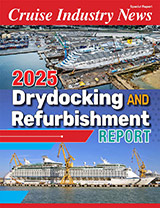Utilizing state-of-the-art technologies and extensive expertise, Halton has focused on developing unique systems that provide energy-efficient solutions for capture of airborne impurities and heat loads in professional kitchens and galleys. The results of these systems allow for a more comfortable, safer and productive thermal environment at reduced operational costs.
Halton Capture JetTM technology increases hood efficiency
Halton Capture JetTM technology is the system that can reduce a galley ventilation’s energy bill up to 30% and at the same time improve the air quality. By improving the total efficiency of the ventilation system, it is possible to gain savings in both initial investment and running costs, while also increasing worker productivity by improving indoor climate conditions.
Capture efficiency is the ability of the galley ventilation system to provide sufficient capture and containment at a minimal exhaust flow rate. Halton Capture JetTM technology creates negative pressure along the front edge and side of the hood and assists in capture and containment of heat and effluents in the critical work area.
The high-efficiency of Halton galley ventilation systems is based on the unique Capture JetTM technology, which reduces the effective net exhaust volumes while improving extraction efficiency, with fan and ductwork size minimized. Capture JetTM hoods prevent heat and impurities produced by cooking appliances from spreading to the work area. The hoods deliver a small air jet – the Capture JetTM – to push the upward-flowing thermal current toward the filters.
Compared to conventional exhaust-only canopies, Capture JetTM technology has a 30 to 40% lower required exhaust volume for extracting an equivalent heat load. Capture JetTM hoods include Halton patented KSA filter, which remove 95% of grease particles sized eight microns and above. The remaining grease particles are filtered with UV-light technology.
Halton’s UV-light technology offers superior grease filtration
Halton Group, the leading manufacturer of commercial kitchen and galley systems, provides its hoods with UV-light technology that offers safer and more hygienic galleys for cruise ships, vessels and offshore installations. The UV-light technology, that is the most efficient grease removal system on market, has been well received among the owners. Some of the most luxurious cruise ships are already utilizing the UV-light technology in galley ventilation as at the same time an increasing number of retrofit installation are scheduled for the future.
What is ultraviolet light and how does it work?
UV stands for ultraviolet light, which is most commonly produced by the sun and delivered to the Earth’s atmosphere. UV light has three different bands: UVA, UVB, and UVC. UVA has the longest wavelength, UVB is medium and UVC has the shortest wavelength. UVC is the type used for germicidal applications and is commonly seen in both water and air sterilization applications. UVC producing lamps come in two varieties: ozone producing and non-ozone producing. For the galley hood application, the added ozone production has proven to be beneficial in destroying grease.
In ships’ galleys most of the grease exhausted from the hood can be classified as fatty acids; an example being oleic acid, which is the primary fat in ground beef. These substances consist of long chains of molecules connected by double bonds, which are chemically reactive. One chemical reaction that occurs is called Photolysis and takes place when UV-light hits the long molecular chains and breaks the double bonds resulting in smaller molecular chains of grease.
The second chemical reaction is called Ozonolysis in which the ozone generated by the lamps continues to react with the smaller chains of grease and grease vapors to chemically alter them. The resulting substance will not stick to the ductwork or fans (as grease does) which helps eliminate a serious fire risk.
Halton’s filtration concept:
· KSA multi-cyclone filter can extract up to 95% of grease particles above 8 microns
· A combination of KSA and a mesh filter increases the filtration efficiency up to 50% with grease particles between 5-8 microns
· UV-light eliminates remaining grease particles resulting in the most efficient grease filtration system in the market.
Results after 10 months of operation
Halton Marine conducted an independent survey on the galley ducts on board ship after ten months of operation. The results are undisputable and show that the UV-light technology decreases grease accumulation in hoods and ductwork. The UVC-radiation and ozone generated not only affected the inside surfaces of the hoods, but also several meters along the ductwork providing enough reaction time for the ozone.
The UV-lamps, located inside the hoods, were found to be clean after several thousands of hour’s operation time. The water wash system cleans the lamp surfaces daily according to the automatic washing program. This is necessary in order to keep lamp radiation efficiency high and the chemical reaction, Ozonolysis, running optimally. In case there is not water wash system integrated in the hood, the UV-lamps can be wiped clean manually.
The following pictures present corresponding locations in the hoods and in the ductwork. Pictures on the left present the situation without UV-equipment, and on the right with the Halton UV-equipment.
After proven results, the hoods that were not originally utilizing UV-light technology were equipped with the UV-light technology as a retrofit installation. A new survey conducted after a sufficient time period showed that the retrofit UV-system installed on hoods operates well and the amount of grease on the duct had substantially decreased.
Conclusion
Halton’s unique Ultraviolet Light combined with Capture JetTM technology is the best solution for hoods with high utilization rate. In UV-light concept most of the medium to large grease particles must be first filtered with high efficiency mechanical filtration (Halton type KSA) and remaining grease with UV-light technology resulting in clean exhaust ducts. The cleanliness provides improved hygienic conditions, reduces fire risk and reduces need for cleaning of the ductwork. In addition to improved fire safety and hygienic conditions this means direct savings in costs.
Benefits of utilizing UV-light technology
· Clean exhaust ducts and hood interior for improved hygiene; UV radiation in the 200 – 300 nanometer range is extremely effective in killing micro-organism
· Substantially reduced duct cleaning costs
· Reduced risk of fire due to clean exhaust ducts
· Reduced odour emissions
· Low airflow rates and savings in energy consumption with Halton Capture JetTM technology
· Filters and lamps are automatically washed daily to ensure effective operation (water wash model)
· Comfortable and safer working conditions and increased productivity in the galleys
· Scientifically and on board proven results with world-wide references on land and sea



